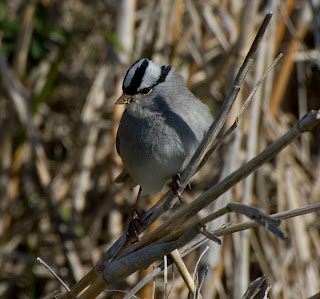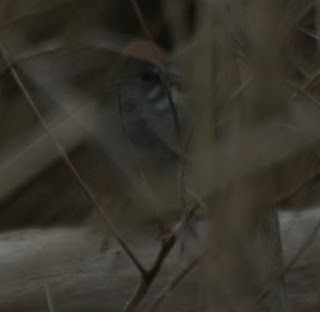On Wednesday while driving near Bell City, I saw a White-tailed Hawk, pictured in the previous post, below. I also saw it do something I hadn't seen a good-sized hawk do before. In what seemed like the middle of a bout of preening, it jumped up off the ground and took off chasing a distant kestrel, easily overtaking it and then dodging and diving after it until it finally forced the kestrel to fumble whatever food item it had been carrying. Here are some photos of the chase. The White-tailed Hawk is the big bird that looks like it would never be able to maneuver with a little falcon. The kestrel is the little bird that's probably wondering where in the world this strange hawk that it can't out-fly has come from.
Friday, February 24, 2012
Wednesday, February 22, 2012
02/22/12
Monday, February 20, 2012
Two More
 |
| Song Sparrow. A rare open look; these birds are extroverts in summer, but skulkers in winter. |
Sunday, February 19, 2012
Moss Lake Quad
The day started out cold, dark, and windy, and the birds were playing hard to get. Among the few passerines early was this Spotted Towhee. The picture is pretty bad, but I did record some video of it calling.
One big surprise for me was a pair of Brown-headed Nuthatches. I thought the nice stand of pines on the east side of the quad looked good enough for them, but I'd never seen this species south of I-10 before.
Fenton Quad
I was kind of shocked when I saw that the Fenton Quad hadn't even received 10 hours of coverage. This area includes Turf Grass Road and Miller Oilfield Road among others, and is a favorite spot of many birders.
As I was scanning pipits on the turf field, I saw home hawks circling in the distance. One was a Ferruginous Hawk. It was pretty far, and even though it circled closer to Turf Grass Road, my pictures aren't very great.
On Miller Oilfield Road, I was hoping to kick up a Ground Dove. Instead, a plump bird about the size of a Ground Dove flew up and landed in a roadside tree. It was a Lark Bunting.
It flew down to the field on the south of the road, and to my left, I saw a bird hopping out of the brush onto the roadside. This one was a Green-tailed Towhee.
What a bizarre winter, when someone can sit and watch a Lark Bunting feeding on one side of the road, and a Green-tailed Towhee 20 yards away on the other side.
A strange day made stranger by the water everywhere, and the birds taking advantage of it. This yellowlegs was enjoying America's roads.
The day started out cold, dark, and windy, and the birds were playing hard to get. Among the few passerines early was this Spotted Towhee. The picture is pretty bad, but I did record some video of it calling.
One big surprise for me was a pair of Brown-headed Nuthatches. I thought the nice stand of pines on the east side of the quad looked good enough for them, but I'd never seen this species south of I-10 before.
Fenton Quad
I was kind of shocked when I saw that the Fenton Quad hadn't even received 10 hours of coverage. This area includes Turf Grass Road and Miller Oilfield Road among others, and is a favorite spot of many birders.
As I was scanning pipits on the turf field, I saw home hawks circling in the distance. One was a Ferruginous Hawk. It was pretty far, and even though it circled closer to Turf Grass Road, my pictures aren't very great.
On Miller Oilfield Road, I was hoping to kick up a Ground Dove. Instead, a plump bird about the size of a Ground Dove flew up and landed in a roadside tree. It was a Lark Bunting.
It flew down to the field on the south of the road, and to my left, I saw a bird hopping out of the brush onto the roadside. This one was a Green-tailed Towhee.
What a bizarre winter, when someone can sit and watch a Lark Bunting feeding on one side of the road, and a Green-tailed Towhee 20 yards away on the other side.
A strange day made stranger by the water everywhere, and the birds taking advantage of it. This yellowlegs was enjoying America's roads.
Sunday, February 12, 2012
Lacassine Quad, 2 12 12
I like to drive the roads between the Lacassine exit off of I-10 and Highway 14. Every time I go down to the coast that way, I pick a new combination of roads to travel. Part of the fun is that the roads are mostly gravel and have very little traffic. Part is that it beats traveling on a bird-less highway. I don't know if I'd call it a birding destination, but this area is fun to bird.
However, today this quad was my destination. I spent 10 chilly hours there gathering data for the winter bird atlas. Here are some of the birds I photographed:
However, today this quad was my destination. I spent 10 chilly hours there gathering data for the winter bird atlas. Here are some of the birds I photographed:
 |
| Grasshopper Sparrow: Good winter for them. |
 |
| Harris's Sparrows. Birds 2 and 4 from left. |
 |
| Red-tailed Hawk. |
 |
| Vesper Sparrow. Neat little sparrow with a bold eyering. |
 |
| White-crowned Sparrow. Pretty dapper little bird. |
 |
| Yellow-bellied Sapsucker |
 |
| Clay-colored Sparrow. This was the first of 2 today. |
 |
| Same Clay-colored as above. Getting warm in a sunny windblock. |
 |
| Clay-colored Sparrow. Second of the day. |
Tuesday, February 7, 2012
Sunday, February 5, 2012
Towhee Trifecta
I had my first-ever Louisiana "towhee trifecta" today, on the Grand Chenier winter bird atlas quad. All three birds were on Little Chenier Road east of Muria Road. This is the year to do it, with excellent numbers of Spotted and Green-tailed Towhees around.
 |
| Spotted Towhee and Eastern Towhee. Can't ask for more cooperative towhees. |
 |
| Green-tailed Towhee. This one took some effort to see, and even more to photograph. |
Cool Canine
Went almost to the coast to do the Creole and Grand Chenier Quads today. On Little Chenier Road, I had the following creature of interest:
Dark coyote? Coy-dog? Pretty awesome sight, whatever it was.
Mac Myers sent me the following regarding canines:
Dark coyote? Coy-dog? Pretty awesome sight, whatever it was.
Mac Myers sent me the following regarding canines:
New York State State Museum scientist says wolves and coyotes in St.
Lawrence County and the rest of the eastern U.S. are hybrids between gray wolves, coyotes and domestic dogs.
Dr. Roland Kays, the museum's curator of mammals, has co-authored a new research article, representing the most detailed genomic study of its kind.
He is one of 16 national and international scientists who collaborated on the study that used the dog genome to survey the global genetic diversity in dogs, wolves and coyotes.
The study used over 48,000 genetic markers, making it the most detailed genomic study of any wild vertebrate species.
The research results are especially relevant to wolves and coyotes in the Northeast. The study shows a gradient of hybridization in wolves, with pure wolves in western states and increasing hybridization as you move east.
Populations of eastern coyotes, which only colonized the region in the last
60 years, were minor hybrids, with some introgression of genetic material from wolves and domestic dogs. For example, Northeastern coyotes, including those in New York State, had genetic material primarily from coyotes (82 percent), with a minor contribution from dogs (9 percent) and wolves (9 percent).
Midwestern and southeastern coyotes were genetically 90 percent coyote, with an average of 7.5 percent dog and 2.5 percent wolf.
Wolves in the western Great Lakes area averaged a genetic makeup of 85 percent wolf and 15 percent coyote, while wolves in Algonquin Park in eastern Ontario averaged 58 percent wolf, and the 'red wolf' in North Carolina was only 24 percent wolf and 76 percent coyote.
The advanced genetic techniques used in this study also allowed the scientists to estimate when the hybridization initially occurred. Kays said "In most cases this breeding across species lines seems to have happened at times when humans were hunting eastern wolves to extinction, and the few remaining animals could find no proper mates, so took the best option they could get." Kays continues, "The exceptions were an older hybridization between coyotes and wolves in the western Great Lakes dating from 600-900 years ago, and a coyote-dog hybridization in the eastern U.S. about 50 years ago, when coyote were first colonizing eastern forests."
This study also provides fresh data on the controversy over the species status of the Red Wolf in North Carolina, and the Eastern Canadian Wolf in Ontario. Both are medium-sized wolves that some have argued represent unique species. However, this new detailed genetic data shows both are the result of hybridizations between coyotes and wolves over the last few hundred years, and do not share a common origin in a unique eastern wolf species.
This research is also relevant to a recent U.S. Fish and Wildlife proposal to remove the western Great Lakes wolves from the Endangered Species Act by showing that those wolves are only marginally hybridized with coyotes, should be considered a subspecies of the Gray Wolf, and have no genetic ties to a more endangered form of eastern wolf.
The research is published online in Genome Research, an international, peer-reviewed journal that publishes outstanding original research that provides novel insights into the genome biology of all organisms, including advances in genomic medicine.
This study follows another research paper co-authored by Kays last year in the journal Biology Letters, which used museum specimens and genetic samples to show that eastern coyotes hybridized with wolves to rapidly evolve into a larger form over the last 90 years, dramatically expanding their geographic range and becoming the top predator in the Northeast. This hybridization contributed to the evolution of coyotes from mousers of western grasslands to deer hunters of eastern forests. The resulting coy-wolf hybrids are larger, with wider skulls that are better adapted for hunting deer.
In the past, Kays has also studied coyote diet and distribution in Albany's Pine Bush and in the Adirondack Mountains. His research indicated that deer accounted for approximately one-third of the coyote's diet and that they made extensive use of forested areas.
Wednesday, February 1, 2012
Weekend of January 25th and 26th
Last weekend, I worked the Mire Quad for the winter bird atlas, getting it over the 20-hour mark, and then went down to the coast with Dave Patton and Mac Myers to explore Sabine Pass in Dave's boat.
The Mire Quad is just northwest of Lafayette, but the land is slightly different, a little higher and drier, maybe, and with a bit of a wave to it. The area featured mostly dry fields and thin roadside treelines. Nothing fancy there, but fun stuff:
 |
| Carolina Chickadee |
 |
| Carolina Wren |
 |
| Common Ground Dove. One of three that I came across. |
 |
| Hermit Thrush |
 |
| Yellow-rumped Warbler. The Swiss Army Warbler. |
 |
| White-throated Sparrow |
The trip to the coast was fun, The seas were rough, but the water was okay inside the channel.
 |
| Bonaparte's Gull |
 |
| Brown Pelican |
 |
| American Oystercatcher. These are always a treat. |
 |
| Herring Gull |
Subscribe to:
Posts (Atom)























